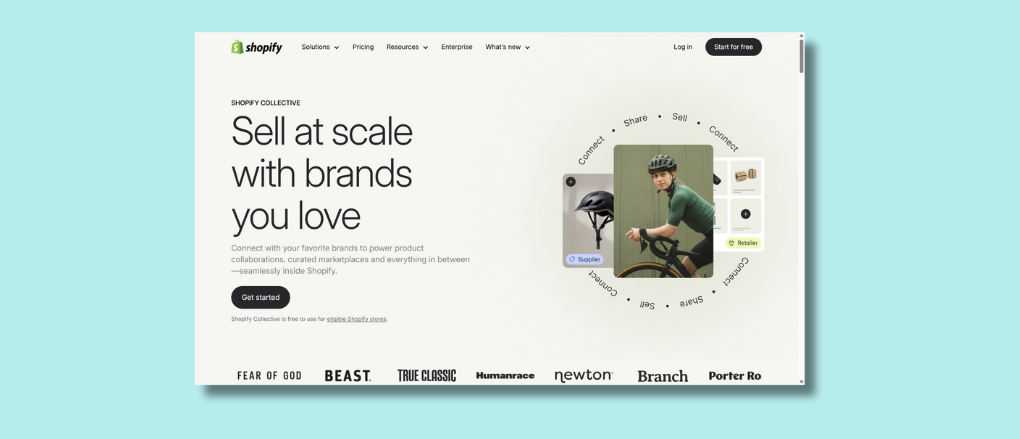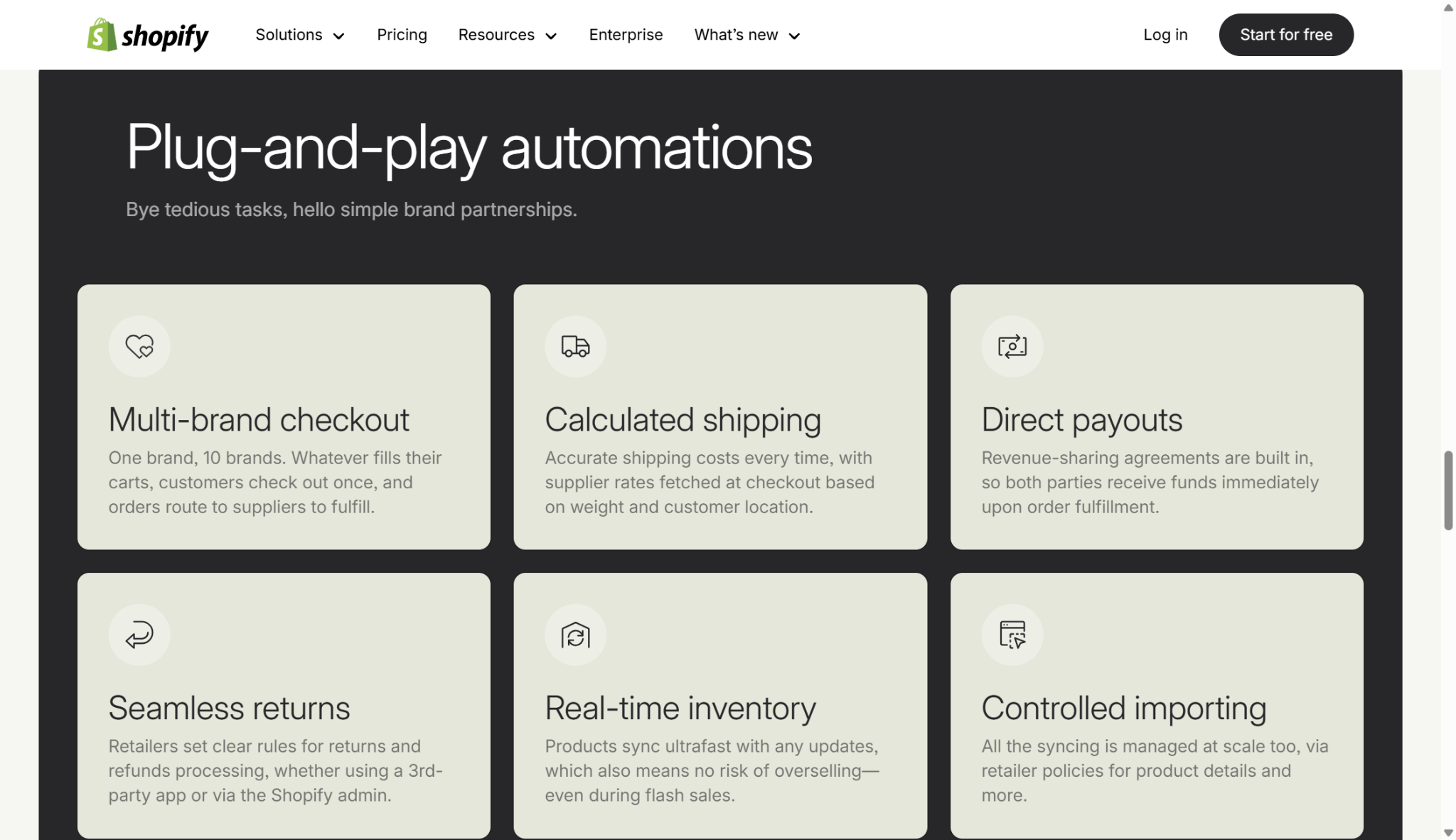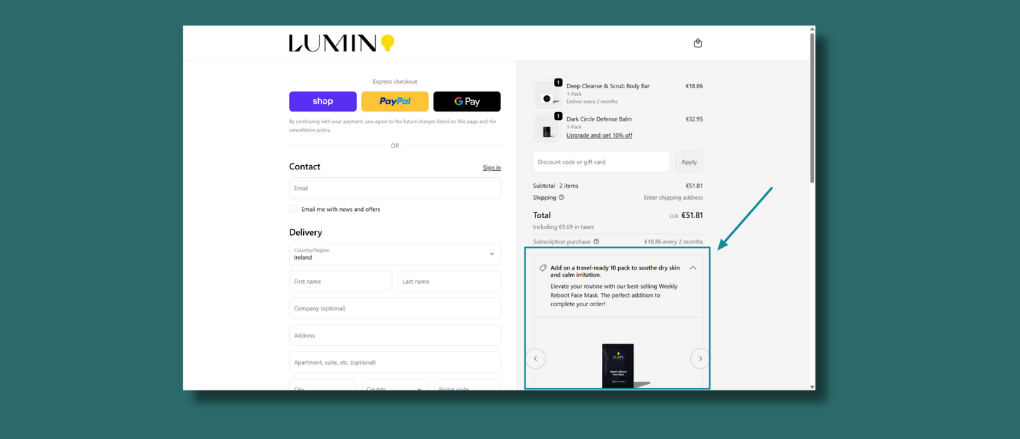Shopify Collective: Everything You Need to Know

Customer acquisition costs are up more than 200% in the past decade.
And if you run a Shopify store, you’ve probably felt the pinch.
Ads are more expensive, margins are tighter, and it’s harder than ever to stand out in crowded markets.
But here’s the good news: you don’t have to do it all alone.
Shopify Collective is Shopify’s answer to the cost of acquisition problem.
It gives merchants a way to collaborate, cross-sell, and build new revenue streams without spending a cent more on ads or taking on extra inventory risk.
In this guide, we’ll break down what Shopify Collective is, why it matters for DTC brands, and how you can use it to grow smarter in 2025 and beyond.
What is Shopify Collective?
At its core, Shopify Collective is a partnership engine for merchants. Instead of competing for the same customer’s attention, Shopify stores can team up, sell each other’s products, and win together.
Here’s how it works in simple terms:
- Expand your catalog instantly - Add partner products to your store without buying or holding stock.
- Offer curated bundles - Combine complementary products into bundles (think coffee + mugs, or yoga mats + activewear).
- Reduce CAC - Tap into partner audiences instead of relying only on ads.
- Delight customers - Deliver more complete shopping experiences with minimal effort.
Why Shopify Collective Matters for DTC Growth

Let’s be real, scaling a DTC brand in 2025 isn’t the same game it was five years ago.
- Ad costs are skyrocketing: Facebook and TikTok ads aren’t the cheap goldmine they once were.
- Data is harder to track: iOS privacy updates made targeting less precise.
- Markets are saturated: Customers are overwhelmed with choices.
This trifecta makes it tougher for brands to grow profitably. But that’s where Shopify Collective changes the equation.
Instead of relying only on paid acquisition, Collective lets you grow through collaboration. By partnering with other Shopify merchants, you can:
- Access new audiences without spending more on ads.
- Add value to existing customers by recommending complementary products.
- Increase average order value (AOV) by bundling relevant items.
- Strengthen brand trust by aligning with like-minded businesses.
Think of it as a new growth lever for DTC brands. Instead of competing for the same shrinking attention span, merchants can pool their strengths and win together.
And the best part? It’s all powered natively inside Shopify, meaning no clunky third-party integrations or messy revenue-sharing contracts.
In other words, Shopify Collective is collaborative commerce made simple. It turns your store from a solo act into part of a curated ecosystem, where each partnership adds value for both the merchant and the customer.
How Shopify Collective Works (Step-by-Step)
Shopify Collective sounds powerful, but the magic is in how simple it is to use. Here’s the exact flow:
- Enable Shopify Collective in your admin
Head to your Shopify dashboard, install the Collective feature, and switch it on. No extra apps or plugins required. - Find and invite partner stores
You can invite other Shopify merchants you already know, or accept invitations from brands that want to work with you. - Choose products to share or sell
Select which items from your catalog you’d like other stores to sell, or import their products into your store. - Sync catalogs automatically
Once accepted, products appear instantly in your partner’s store, complete with descriptions, pricing, and images. Updates flow automatically, so you’re always in sync. - Track and fulfill orders seamlessly
When a partner sells one of your products, you handle the fulfillment as usual. Payments and reporting are managed right inside Shopify.
In other words: no spreadsheets, no back-and-forth contracts, no manual uploads. Just a few clicks and your store is part of a bigger, collaborative ecosystem.
Real-World Examples of Shopify Collective in Action
Real merchants, real results - these Shopify case studies show how Collective drives growth and engagement:
1. Ten Thousand × GORUCK (Fitness Apparel Collab)

Ten Thousand partnered with GORUCK for a limited edition drop using Shopify Collective. The result? A 46 % increase in average order value, and 16 % of sales coming from entirely new customers.
2. Larroude (Luxury Fashion Marketplace)

Larroude transformed its site into a curated luxury shopping destination by pulling in products from partner suppliers via Shopify Collective. Within just one month, they saw a 21 % revenue increase, 82 % of Collective sales came from first‑time customers, and a modest 5 % lift in AOV - all while launching six new product categories.
3. Cozy Earth + Fount Society (Sister-Brand Cross-Selling)

Cozy Earth used Collective to cross‑sell products from its sibling brand, Fount Society, without duplicating SKUs or managing separate storefronts. The payoff was significant: 46 % of Fount Society’s revenue came via Collective, over 60 % of its web traffic was driven by the co‑brand funnel, and 36 % of its sales came from new customers landing via Cozy Earth.
These examples make one thing clear: Shopify Collective isn’t just about connecting stores; it enables seamless collaborations that boost AOV, attract fresh audiences, and elevate your brand’s offering.
Shopify Collective vs Traditional Partnerships

Before Shopify Collective, brand partnerships were often messy and slow to execute. Think: endless email chains, manual product uploads, clunky affiliate links, and customers bouncing between sites just to complete a purchase.
Here’s how Shopify Collective changes the game:
The difference is simple: Collective makes partnerships scalable and native. Instead of bolting on a complicated integration, Shopify bakes it right into your store’s infrastructure - meaning less friction for you and a smoother journey for your customers.
Advanced Strategies to Maximize Shopify Collective
Once you’ve connected with partner brands, the real upside comes from how you execute. Here are a few advanced plays to squeeze the most out of Shopify Collective:
1. Curate Partnerships, Don’t Just Add Products
Choose brands that complement your own. A skincare line pairs naturally with supplements, but not with electronics. Alignment makes the collaboration feel authentic, which drives trust and repeat purchases.
2. Create Bundled Experiences
Go beyond listing partner products individually. Curate themed bundles — “Holiday Gift Sets,” “Weekend Essentials,” or “Wellness Starter Kits.” Bundles make it easier for customers to spend more, without feeling like they’re overspending.
3. Cross-Promote Through Owned Channels
Announce collaborations in your email campaigns, SMS flows, and social media. When both brands push the same products to their lists, you instantly double the exposure.
4. Leverage Seasonal Opportunities
Use Collective to expand your catalog during peak moments like Black Friday, Valentine’s Day, or Mother’s Day. Temporary partnerships can help you ride seasonal demand without long-term inventory commitments.
5. Track What Moves the Needle
Keep an eye on AOV, CAC, and repeat purchase rates. Not every partnership will be a home run, but the data will show which collaborations actually grow your business.
The best advice is to treat Shopify Collective as a long-term strategy, not a one-off test. The compounding benefits come from building a curated ecosystem of trusted brand partners over time.
Common Mistakes to Avoid with Shopify Collective
Shopify Collective makes partnerships simple, but that doesn’t mean every collaboration will be a win. Many merchants stumble by rushing in without a strategy. Here are the pitfalls to sidestep:
1. Partnering with the Wrong Brands
If your partner doesn’t align with your audience, it creates confusion instead of value. A premium homeware brand pairing with a discount gadget seller? That’s a recipe for mistrust.
2. Ignoring Pricing Alignment
When partner products are drastically cheaper or more expensive than yours, the mismatch can hurt conversions. Make sure pricing tiers feel cohesive.
3. Treating It as “Set and Forget”
Adding partner products isn’t enough. You need to promote them, bundle them, and explain why they’re worth buying together.
4. Overloading Your Catalog
Too many partner products dilute your store’s identity. Customers want curated, relevant additions — not a marketplace free-for-all.
5. Skipping Performance Tracking
Without monitoring AOV, sales attribution, and repeat purchases, you won’t know which collaborations are working. Data should guide which partnerships you double down on.
Bottom line: Treat Shopify Collective like any other growth channel. Strategic curation, clear messaging, and data-driven optimization separate the winners from the wasted effort.
Drawbacks of Shopify Collective
Even the best tools come with trade‑offs. Here are real concerns flagged by merchants and eCommerce experts:
1. Missing Product Data
Merchants report that imported items sometimes lack critical details like SKUs, barcodes, collection tags or full descriptions. That means manual cleanup—and the risk of broken automation or inventory tracking issues.
2. Flat Pricing Structure
Collective applies a single commission or markup across the catalog. That leaves you with no flexibility to adjust margins per SKU—which can hurt profitability on products with wide price ranges.
3. Sync & Fulfillment Glitches
Several merchants have encountered order delays or “stuck” orders—payments not forwarding properly to suppliers, and fulfillment left on hold. One user shared:
“The order … never attempted to debit the supplier cost … fulfillment was never triggered … new smaller orders processed, while the high‑value order sat unresolved.”
That kind of glitch threatens customer satisfaction and trust.
4. Label & Packing Slip Confusion
Some brands still manually adjust shipping labels or packing slips for Collective orders, adding needless overhead to fulfillment. One merchant lamented that this may become unsustainable as volume grows.
5. Chargeback Risk as a Supplier
Suppliers worry about fraud or chargebacks—especially with high‑value orders. One merchant selling fragile equipment raised a red flag:
“If a Collective customer gets a chargeback, does it affect my chargeback rate? Will I be compensated?”
That's a serious operational and financial concern if there's no clear chargeback policy.
6. Discoverability & Support Friction
Merchants report struggles finding help on Shopify forums—searching for “Collective” often returns posts about “collections,” making peer support less accessible
Summary Table: Shopify Collective Drawbacks
Who Should Use Shopify Collective?
Shopify Collective isn’t for every store. But for the right merchants, it can be a growth accelerator. Here’s who stands to benefit most:
1. Shopify Store Owners Looking to Expand Catalogs Quickly
If you want to offer more variety without the headache of sourcing or storing extra inventory, Collective is a plug-and-play solution.
2. Brands in Complementary Niches
Food + drink, apparel + accessories, fitness + wellness—if your products fit naturally together, Collective lets you serve a more complete experience.
3. Agencies Running Multi-Brand Portfolios
Agencies managing several Shopify clients can use Collective to create cross-store bundles and boost sales across the portfolio.
4. CRO and Retention Marketers
Collective gives you new levers to pull for increasing AOV and customer lifetime value. Partner products can be woven into upsells, bundles, and loyalty campaigns.
5. Early-Stage Entrepreneurs on Shopify
If you’re still testing your market, Collective lets you grow your catalog and test demand for new categories without heavy upfront investment.
Shopify Collective: Key Takeaways
Shopify Collective is more than just another Shopify feature, it’s a shift in how DTC brands can grow. Instead of fighting the uphill battle of rising ad costs and saturated markets, merchants can tap into collaboration as a growth engine.
Here’s what to remember:
- Shopify Collective lets merchants sell each other’s products natively inside Shopify with no clunky third-party tools.
- It helps brands expand product catalogs, boost AOV, and lower customer acquisition costs through smart partnerships.
- Real-world examples like Ten Thousand, Larroude, and Cozy Earth show measurable results in revenue growth and new customer acquisition.
- The platform isn’t perfect - merchants should be aware of drawbacks like product data gaps, fulfillment hiccups, and flat pricing structures.
- Collective works best for brands in complementary niches, agencies managing multiple stores, and entrepreneurs looking to test new markets without risk.
👉 Bottom line: Shopify Collective makes collaborative commerce easy, scalable, and accessible. For the right stores, it’s a low-barrier way to drive growth by teaming up instead of going it alone.
Shopify Collective FAQ
Let’s quickly cover some of the most commonly asked questions relating to Shopify Collective.
What is Collective on Shopify?
Shopify Collective is a built-in feature that allows Shopify merchants to partner with each other, sell each other’s products, and expand their catalogs without holding inventory. It’s designed to boost AOV, lower customer acquisition costs, and make brand collaborations seamless.
How to qualify for Shopify Collective?
To use Shopify Collective, your store must be based in the United States and use Shopify Payments. At the moment, it’s not open to all regions. Shopify may also review your store’s history and reliability before approving you as a supplier or retailer.
How much does Shopify Collective cost?
There is no upfront fee to join Shopify Collective. Instead, suppliers earn revenue when their products are sold through partner stores, and retailers pay the wholesale cost agreed upon with the supplier. Pricing flexibility is limited since Collective applies a flat commission model.
What is Shopify Collective Debit?
Shopify Collective Debit is the payment system that facilitates transactions between retailers and suppliers. When a customer buys a product from a retailer’s store, Shopify automatically debits the retailer’s account and pays the supplier their share. This keeps payments smooth without manual invoicing.
Can international merchants use Shopify Collective?
Currently, Shopify Collective is only available to U.S.-based merchants. Shopify has not yet announced a timeline for expanding to other countries.
Does Shopify Collective affect order fulfillment?
Yes - suppliers are responsible for fulfilling any orders placed through Collective. Retailers don’t hold inventory, so the fulfillment process flows directly from the supplier to the end customer.





.jpg)


